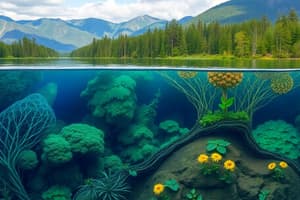Podcast
Questions and Answers
Which process is responsible for the conversion of ammonia into nitrates in the nitrogen cycle?
Which process is responsible for the conversion of ammonia into nitrates in the nitrogen cycle?
- Decomposition
- Denitrification
- Nitrification (correct)
- Nitrogen fixation
What role do decomposers play in the ecosystem?
What role do decomposers play in the ecosystem?
- They produce energy through photosynthesis.
- They recycle nutrients from dead organisms. (correct)
- They convert solar energy into chemical energy.
- They consume primary producers.
How does water vapor return to Earth in the water cycle?
How does water vapor return to Earth in the water cycle?
- Precipitation (correct)
- Evaporation
- Transpiration
- Condensation
What is the primary source of nitrogen for plants?
What is the primary source of nitrogen for plants?
What process involves the conversion of nitrogen gas into ammonia?
What process involves the conversion of nitrogen gas into ammonia?
In an ecosystem, what do autotrophs primarily do?
In an ecosystem, what do autotrophs primarily do?
Which of the following best describes how carbon cycles through the environment?
Which of the following best describes how carbon cycles through the environment?
What two factors are primarily cycled in the carbon-oxygen cycle?
What two factors are primarily cycled in the carbon-oxygen cycle?
What is one of the primary roles of bacteria in soil within the nitrogen cycle?
What is one of the primary roles of bacteria in soil within the nitrogen cycle?
Which organisms are primarily responsible for breaking down dead plants and animals in the ecosystem?
Which organisms are primarily responsible for breaking down dead plants and animals in the ecosystem?
Flashcards are hidden until you start studying
Study Notes
Cycles of Materials
- Ecosystems are in a state of approximate equilibrium, with cyclic changes in materials.
- Materials like carbon, oxygen, hydrogen, and nitrogen must be recycled and reused between the living and nonliving environment.
Carbon-Oxygen Cycle
- Carbon dioxide and water molecules are used in photosynthesis to form energy-rich organic compounds.
- These organic compounds are returned to the environment when the energy is eventually released by cells.
Water Cycle
- Water moves between the Earth's surface and atmosphere.
- Liquid water turns into water vapor through evaporation and transpiration.
- Water vapor gathers in clouds and returns as precipitation through condensation.
Nitrogen Cycle
- Plants obtain nitrogen from the soil.
- Nitrogen is essential for living things as it is part of the amino acids and proteins (-NH2).
- Animals consume plants to get nitrogen.
- Decomposers (bacteria and fungi) recycle dead plants, animals, and waste in the soil.
- Nitrifying bacteria convert ammonia into nitrates.
- Nitrogen-fixing bacteria convert nitrogen gas into ammonia.
- Denitrifying bacteria convert nitrates into nitrogen gas.
Bacteria In Ecosystems
- Bacteria play a crucial role in the flow of materials through ecosystems.
- Decomposers like bacteria break down organic matter, releasing nutrients back into the ecosystem.
Soil Bacteria
- When animals excrete nitrogenous wastes into the soil, certain soil bacteria convert these wastes into nitrates.
- These soil bacteria are decomposers, consuming and breaking down organic matter.
Studying That Suits You
Use AI to generate personalized quizzes and flashcards to suit your learning preferences.




